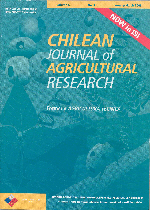
|
Agricultura Técnica
Instituto de Investigaciones Agropecuarias, INIA
ISSN: 0365-2807
EISSN: 0365-2807
Vol. 66, No. 1, 2006, pp. 98-106
|
 Bioline Code: at06011
Bioline Code: at06011
Full paper language: Spanish
Document type: Note
Document available free of charge
|
|
|
Agricultura Técnica, Vol. 66, No. 1, 2006, pp. 98-106
| en |
Characterization of asparagus ( Asparagus officinalis  L.) cultivar growth in pots in the first year L.) cultivar growth in pots in the first year
Pertierra, Rosa; Campos, Jorge & Carrasco, Francisco
Abstract
To study the growth of four asparagus ( Asparagus officinalis

L.) cultivars during the first year after seeding, a pot experiment was established in Ñuble province (36°34' S lat, 72°06' W long, Chile). The cultivars evaluated were Atlas, UC157F1, JWC1 and UC157F2. A high positive correlation between accumulation of biomass and time (days after seeding) and also with temperature was found. The lineal model biomass vs. time had a high correlation (r = 0.96), because of which it might not be necessary to include climatological data to estimate growth at this crop stage. Including the photosynthetic active radiation did not improve the thermal lineal model. For foliage and crowns, lineal growth models (relative growth rates) were found, that corresponded to the slope of the line, that only differed between cv. Atlas and UC157F2. Nevertheless, this did not translate into differences for the majority of vegetative parameters evaluated. The cv. UC157F1 only differed in dry weight from the foliage of JWC1 and in the number of shoots from Atlas.At the root level, there were no differences between cultivars, except in soluble solids (UC1571 less than JWC1). The new cultivars, Atlas and JWC1, showed a similar final crown quality to the traditional UC157 hybrids, expressed as fresh weight, bud number and root number.
Keywords
relative growth rate, degree-days, solar radiation, biomass, soluble solids.
|
| |
| es |
Caracterización del crecimiento en el primer año de cultivares de esparrago ( Asparagus officinalis  L.) en maceta L.) en maceta
Pertierra, Rosa; Campos, Jorge & Carrasco, Francisco
Resumen
Para evaluar el crecimiento de cuatro cultivares de espárrago ( Asparagus officinalis

L.) durante el primer año desde siembra se estableció un ensayo en la Provincia de Ñuble (36°34' lat. Sur, 72°06' long. Oeste, 144 m.s.n.m). Los cultivares evaluados fueron: Atlas, UC157F1, JWC1 y UC157F2. Se observó una alta correlación positiva entre la acumulación de biomasa y el tiempo (días desde siembra) y también con la temperatura. El modelo lineal biomasa vs. tiempo obtuvo una alta correlación (r = 0,96), por lo que no sería necesario contar con datos climáticos para estimar el crecimiento del espárrago en esta etapa. La inclusión de la radiación fotosintéticamente activa al modelo termal lineal no contribuyó a mejorarlo. Los modelos lineales y por ende las tasas de crecimiento relativo de follaje y corona, que corresponden a la pendiente de la recta, sólo se diferenciaron entre los cv. Atlas y UC157F2. Sin embargo, esto no se tradujo en diferencias para la mayoría de los parámetros vegetativos evaluados. El cv. UC157F1 sólo se diferenció en el peso seco de follaje de JWC1 y en el número de brotes de Atlas. A nivel radicular no hubo diferencias entre cultivares, excepto en los sólidos solubles (UC157F1 menor que JWC1). Los nuevos cultivares Atlas y JWC1 mostraron una calidad final de corona similar a los híbridos tradicionales UC157, expresada como peso fresco, número de yemas y de raíces.
Palabras-clave
tasa de crecimiento relativo, grados-día, radiación solar, biomasa, sólidos solubles.
|
| |
© Copyright 2006 - Instituto de Investigaciones Agropecuarias, INIA (Chile).
Alternative site location: http://www.inia.cl/at/agritec.htm
|
|
